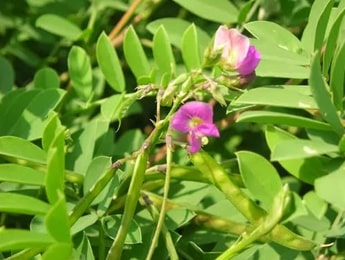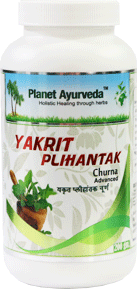SHARPUNKHA (TEPHROSIA PURPUREA) – USES, BENEFITS, PROPERTIES & DOSAGE

DESCRIPTION OF PLANT
Sharpunkha (Tephrosia purpurea) is a Perennial erect herb which is up to 50 cm tall. Stem is woody, 0.5-1.5 cm thick, cylindrical, slightly angular near the apex, outer surface is green and glabrous. Leaves are imparipinnate, leaflets are 7-15, 1-2.8 x 0.3-1 cm, oblanceolate or obovate, base cuneate, apex obtuse to emarginate or truncate, mucronate, stipules 3-6 mm long, lanceolate. Flowers are about 7 mm long, leaf-opposed, pseudoracemes, pedicels are 3-4 mm long, bracts are 2 mm long. Calyx is 3-4 mm long., pubescent, lobes subulate. Corolla is pink to purplish and orbicular. Staminal tube is 4 mm long. Pods are 2.5-4 x 0.3-0.4 cm, linear-oblong, 5-7-seeded. Seeds are ellipsoid, and dark brown.
GENERAL INFORMATION
Sharpunkha has the great medicinal important in Ayurveda. It is a well-known Ayurvedic herb, used in the treatment of liver cirrhosis and splenomegaly. This herb is very beneficial to maintain the healthy hemoglobin levels in body. In Ayurveda Sharpunkha has been identified as the fruitful herb for liver health. Besides this, the herb is good for digestive system and also helps to manage the digestive disorders. This is good herb in cough and respiratory complications. Furthermore this herb is loaded with anti-diabetic and anti-hyper lipidemic properties. There are various photochemical compounds present in this herb like Lupeol, Rutin, Delphinidin chloride, Palmitic, Caffeic acid, Palmitoleic, Tepurindiol, Linoleic acid, Oleic acid,Valine, Threonine, Lysine, Isoleucine, Karanjin, Phenylalanine, Delphinidin chloride, Tephrone. All these phytochemical compounds are packed with amazing properties to resolve the various health issues.
CLASSIFICATION
- Kingdom – Plantae
- Sub kingdom – Tracheobionta
- Super division – Spermatophyta
- Division – Magnoliophyta
- Class – Magnoliopsida
- Subclass – Rosidae
- Order – Fabales
- Family – Fabaceae
- Sub family – Papilonaceae
- Genus – Tephrosia
- Species – Purpurea
HABITAT
It grows as common wasteland weed. In many parts it is cultivated as green manure crop.
NAMES
- Sharpunkha Latin Name – Tephrosia purpurea
- Sharpunkha Sanskrit name – Pleehashatru, Neelavrukshakruti, Shimbiphala, Mahaushadhi, Sharapunkha.
- Sharpunkha Hindi name – Saraponkh
- Sharpunkha English name – Wild indigo or Purple tephrosia
- Sharpunkha Telugu name – Vempali Chettu
- Sharpunkha Marathi name – Unhali
- Sharpunkha Kannada name – Egyali
- Sharpunkha Malayalam name – Katamiri
- Sharpunkha Tamil name – Kolingi
AYURVEDIC PROPERTIES OF SHARPUNKHA
| Hindi / Sanskrit | English | ||
| Rasa | Tikta, Kashaya | Taste | Bitter, Astringent |
| Guna | Laghu, Rooksha, Teekshna | Physical Property | Light, Dry, Piercing |
| Virya | Ushna | Potency | Hot |
| Vipaka | Katu | Metabolic Property (After Digestion) | Pungent |
SHARPUNKHA EFFECTS ON DOSHAS
It balances the vata and kapha doshas.
CLASSICAL CATEGORIZATION
| Charak Samhita | Vagbhata | Sushrut Samhita |
|
Nil |
Nil |
Nil |
ANCIENT VERSE ABOUT SHARPUNKHA – TEPHROSIA PURPUREA

The Bhavprakash nighantu, edition of 2010: verse 210, page no- 407-408.
Sharpunkh, Pleehashatru and Neelivrikshakriti are the different names of Sharpunkha. It is bitter and astringent in taste. Its properties are light. It is good for liver spleen disorders, wounds, toxins, cough, fever and blood disorders.
REFERENCES
The Bhavprakash nighantu with elaborated Hindi commentary by Padmashri prof. K.C. Chunekar, edited by Dr. G.S. Pandey: verse 210, edition of 1998: page no- 407-408.
PRACTICAL USES OF TEPHROSIA PURPUREA
- This is known to be an effective herb for the treatment of liver cirrhosis. It helps in the detoxification of liver and also helps in the regeneration of new liver cells. The herb also provide relief in the symptoms like nose bleeding, weight loss, decreased appetite, jaundice (yellow discoloration), anorexia, itchy skin, weakness, abdominal swelling (ascites) and swelling of the legs (edema). Hence, it is an effective herb for the treatment of liver disorders.
- Use of this herb is quite good to manage the splenomegaly. It helps in production of blood cells. This herb also manage the symptoms like anemia, fatigue, easy bleeding, fullness of stomach and pain in upper abdomen which are associated with splenomegaly.
- This herb is packed with kidney protective properties. It helps to strength the kidney system and aids in the removal of waste material from the body.
- The herb is quite beneficial in the treatment of skin diseases. Insecticidal properties of the herb are used for treating the skin eruptions. Leaves of this herb contain rotenoid, which acts as insecticide. Whereas seeds contain a flavonoid, lanceolarin B, which helps in healing of skin. Hence use of this herb is quite good in the treatment of various skin diseases like eczema, scabies and leprosy etc.
- Anti-diabetic properties of this herb help to maintain the healthy blood sugar levels. Moreover this herb also helps to manage the symptoms of diabetes like increased urination, fatigue, weight loss, excessive thirst, blurred vision and slow healing of the wounds.
- Antipyretic and analgesic properties of this herb are quite good in the treatment of fever.
- This herb is also loaded with anti-inflammatory properties which help to reduce bodyache.
- Antimicrobial activities of herb are quite beneficial to manage the several viral, bacterial and fungal infections.
- It is known to be beneficial herb for the treatment of female reproductive health issues. Use of this herb is quite effective in the treatment of uterine fibroids, ovarian cysts, and PCOS (Polycystic Ovarian Syndrome) etc. This herb helps to reduce the size of cyst and any outgrowth in uterus.
- Anticancer properties of this herb help in treatment of cancer. This herb helps to stop the growth of cancer cells and increases the growth of healthy cells in a natural way without causing any side effect on health.
- Use of this herb is quite good to resolve the digestive disorders. It helps to provide relief in the indigestion, heart burn, intestine pain and acidity etc.
PARTS USED
- Roots
- Whole plant
DOSAGE
3-6 gram powder and 10-20 ml juice.
AYURVEDIC PRODUCTS FROM SHARPUNKHA IN PLANET AYURVEDA
Yakrit Plihantak Churna
Sharpunkha herb is used in the formulation of Yakrit Plihantak churna. This herbal product is very useful for liver disorders. It helps in the detoxification of liver. Enhances the bile production and excretion. Moreover, it helps in the regeneration of liver cells and also provides the relief in the enlargement or inflammation of liver.




